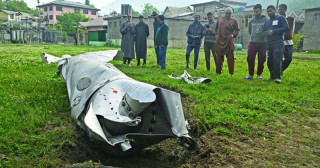Liberal 000
Chief Minister (5k+ posts)
Amir Suri[edit]
Amir Suri was a Hindu[5] king from the ancient Ghorid dynasty in the 9th and 10th century. He was a descendant of the Ghorid king Amir Banji Baharan whose rule was legitimized by the Abbasid caliph Harun al-Rashid after a peace treaty. Amir Suri was defeated in war with the Saffarid ruler Ya'qub ibn al-Layth al-Saffar.
Amir Muhammad ibn Suri[edit]
Muhammad ibn Suri was also, despite his name, a Buddhist king of the Ghorid dynasty from the 10th century to 1011. He fought against Mahmud of Ghazni. According to Minhaju-S Siraj, ibn Suri was defeated and captured by Mahmud of Ghazni, made prisoner along with his son Abu Ali and taken to Ghazni, where ibn Suri died by poisoning himself.[6]
Ibn Suri's son Abu Ali ibn Muhammad (reigning from 1011 to 1035) later converted to Islam, and constructed mosques and Islamic schools in Ghor.[8]
Conversion to Islam[edit]
According to tradition, Surs are descended from the Ghori tribe. Several books by Islamic historians including Tarikh-I-Guzida of Hamdu-lla-Mustaufi, Towareekh Yumny, as well as Ferishta record that besides Muslim Surs there were also Non-Muslim Hindu and Buddhist, pagan Surs, who were attacked by Mahmud of Ghazni and converted to Islam by him.
Origin of the Afghan tribe of Suris
According to Farishta a Suri male expelled from his country Gour took refugee among Afghans married an Afghan women and later his descendants came to be known as Afghan Surs or Suris
Current Hindu Suris and their origin
There is Khatri Hindu Sikh Suri tribe of Punjab but right now they do not claim any link to Gaur , Afghanistan .
Indian (Panjab): Hindu (Khatri) and Sikh name, based on the name of a clan in the Khatri community, from Sanskrit suri ‘sun’, ‘priest’, ‘sage’. It is also an epithet of Krishna.
Amir Suri was a Hindu[5] king from the ancient Ghorid dynasty in the 9th and 10th century. He was a descendant of the Ghorid king Amir Banji Baharan whose rule was legitimized by the Abbasid caliph Harun al-Rashid after a peace treaty. Amir Suri was defeated in war with the Saffarid ruler Ya'qub ibn al-Layth al-Saffar.
Amir Muhammad ibn Suri[edit]
Muhammad ibn Suri was also, despite his name, a Buddhist king of the Ghorid dynasty from the 10th century to 1011. He fought against Mahmud of Ghazni. According to Minhaju-S Siraj, ibn Suri was defeated and captured by Mahmud of Ghazni, made prisoner along with his son Abu Ali and taken to Ghazni, where ibn Suri died by poisoning himself.[6]
It was also the last stronghold of an ancient religion professed by the inhabitants when all their neighbors had become Muslim. In the 11th century AD Mahmud of Ghazni defeated the prince of Ghor Ibn –I-Suri, and made him prisoner in a severely-contested engagement in the valley of Ahingaran. Ibn-I-Suri is called a Hindu by the author, who has recorded his overthrow;[7]
Ibn Suri's son Abu Ali ibn Muhammad (reigning from 1011 to 1035) later converted to Islam, and constructed mosques and Islamic schools in Ghor.[8]
Conversion to Islam[edit]
According to tradition, Surs are descended from the Ghori tribe. Several books by Islamic historians including Tarikh-I-Guzida of Hamdu-lla-Mustaufi, Towareekh Yumny, as well as Ferishta record that besides Muslim Surs there were also Non-Muslim Hindu and Buddhist, pagan Surs, who were attacked by Mahmud of Ghazni and converted to Islam by him.
Sultan Mahumud now went to fight with the Ghorians, who were infidels at that time. Suri, their chief, was killed in this war, and his son was taken prisoner; but he killed himself by sucking poison which he had kept under the stone of his ring. The country of Ghor was annexed to that of the Sultan, and the population thereof converted to Islam. He now attacked the fort of Bhim, where was a temple of the Hindus.[9]
Origin of the Afghan tribe of Suris
According to Farishta a Suri male expelled from his country Gour took refugee among Afghans married an Afghan women and later his descendants came to be known as Afghan Surs or Suris
Current Hindu Suris and their origin
There is Khatri Hindu Sikh Suri tribe of Punjab but right now they do not claim any link to Gaur , Afghanistan .
Indian (Panjab): Hindu (Khatri) and Sikh name, based on the name of a clan in the Khatri community, from Sanskrit suri ‘sun’, ‘priest’, ‘sage’. It is also an epithet of Krishna.












































